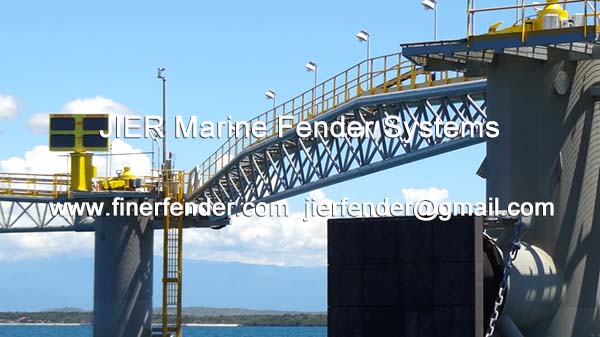Technical Discussions of a Dock Fender System
Since the purpose of a Dock Fender system is to absorb the energy of a berthing ship, it is necessary to examine the factors that make up the total energy package. These factors are:
- Weight of the vessel in displacement tons.
- Berthing velocity normal to the dock.
- Angle of approach.
- Hydraulic Effect.
- Dock design.
1. Weight of vessel
It is common to refer to the ship’s weight in terms of dead weight tonnage (DWT) or displacement tonnage. Displacement tonnage is the more accurate figure to use in computing kinetic energy because it is the total weight of the ship and its cargo and equipment. If the dead weight tonnage is known, multiply DWT by 1.3 to obtain an accurate approximation of the displacement tonnage.
2. Berthing Velocity
Since the kinetic energy possessed by a ship is proportional to the square of the velocity, it is important that the velocity be determined with accuracy. The velocity of a ship approaching a dock is affected by a number of factors:
- the size of the vessel,
- the skill of the crew members,
- the wind and current conditions,
- and whether the ship is making an unassisted berthing or if it is being assisted by tugs.
Since the velocity of a ship is usually given in terms of knots, it is necessary to convert that gure into feet per second as follows:
Knots x 1.09 = Feet per second.
3. Angle of Approach
The angle in which a ship approaches a dock not only influences the effective velocity but also affects which part of the ship makes the initial contact with the pier. Generally, the ship will contact the dock at a point near the bow or the stern. In such cases, the reaction force will impart a rotational movement to the ship and this rotational movement will dissipate a portion of the ship’s energy.
4. Hydraulic Effect
In determining the energy to be absorbed by the fenders, it is also necessary to consider the effect of the water. As a ship makes contact with the dock and its movement is suddenly checked, the mass of water moving with the vessel adds to the energy possessed by the ship. Although there are a number of theories relating to the hydraulic effect, they all deal with the length, beam and draft of the ship.
5. Dock design
To select the proper size and type of Dock Fender the design of the dock must be considered.
If the dock does not have a separate frontal system: the fenders can be mounted directly onto the dock face. Common methods of attaching fenders to this type of dock face include:
- Festooning cylindrical fenders by suspending them with chain.
- Directly bolting Rectangular, Wingtype, D Shaped or Trapezoidal fenders to the dock face.
For either attachment method the fenders can be positioned in a horizontal or diagonal pattern depending on the tidal conditions and the type of vessels being serviced by the pier. In areas of relatively high tides, or on piers that will handle barges as well as ships, it is good practice to mount the fenders in a diagonal pattern in order to protect a greater portion of the dock face.
For docks that have a protective frontal system made up of piles and wales: Rectangular or Trapezoidal fenders are generally mounted between the dock face and the wales. The design strength of the dock also has a bearing on the size and the type of fender to be used. Piers and dolphins which are supported by piles have design limitations with respect to the loads that can be imposed. In these cases, a fender system must be selected that will absorb the energy of the berthing ship and remain within the design limits of the structure.
Having determined the amount of energy to be absorbed and the type of dock to be protected, the next step is to select the proper size and type of fender to specify. Also, the method of attaching the fender can be determined.
Contact Details
- No.8 Jier Road, Jiaozhou Jiaobei Industrial Zone, Qingdao, China
- +86 186 602 306 15
- jierfender@gmail.com
- Contact Form


